The Dominican Republic (DR) was ravaged by Hurricane Fiona in September, 2022, causing a devastating loss to 4,000 cacao farmers in the Hato Mayor and El Seibo regions of the island. There have been approximately 4,000 metric tonnes of cacao damaged by torrential rains in El Seibo alone. To help, The Learning Community International–a nonprofit K-12 educational organization and Foundation Pringamosa have teamed up with award-winning DR-based chocolatier SPAGnVola to help raise funds to help impoverished cacao-growing families. Click this link to support the fundraiser and know that your donations will help our beloved international chocolate community recover from yet another paralyzing natural disaster.
I was truly inspired by a visit to the women’s cocoa cooperative in Vincentillo, a tiny village located in the province of El Seibo in the Dominican Republic. El Seibo is just east of the province of Hato Mayor where I was staying, and is not in close proximity to any tourist destinations. Yet, I was impressed with the progressive initiatives of this group, and wish to salute them in honour of International Women’s Day.
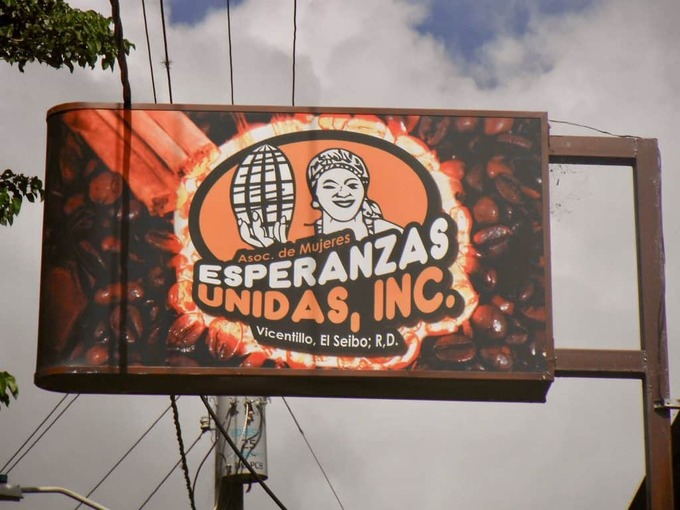
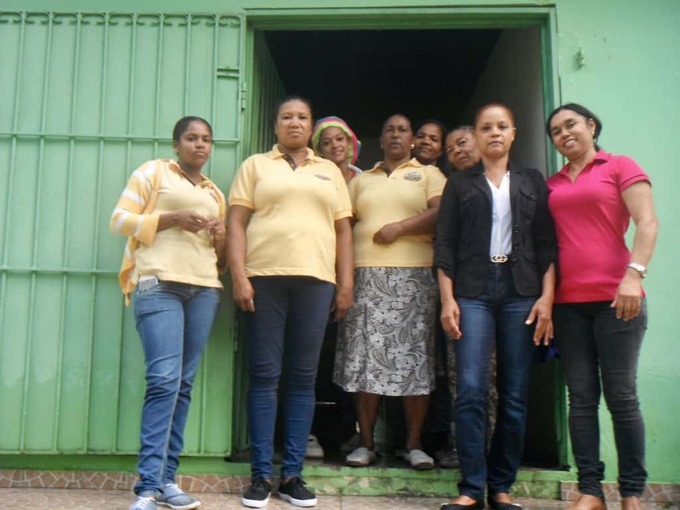
Meeting with the leaders of the Asociación de Mujures Esperanzas Unidas showed me how difficult it is to build your vision. You have to have a clear plan and follow the steps that will get you there.
learning about women’s cocoa cooperatives
The group was formed in 1972, but there are only two or three of the original founders who are still active with the group today. Their membership high was 45. Today, there are 25 members. In 2013, the group received some government funding to help them grow. Slowly, their hard work is paying off and the group is optimistic about its future.
The goals of the Asociación de Mujures Esperanzas Unidas are:
- to produce products that meet international and local standards.
- to always be in production.
- to have good clients.
- to have an abundance of raw materials to work with.
- to have the ability to process their own beans.
Currently, the cooperative only works with processed beans. They do not ferment or dry the beans, but they do roast and winnow them. In the photo below, one of the members of the cooperative shows us some recently winnowed cocoa beans that they will conch (grind) for 24 hours and then make into chocolate.
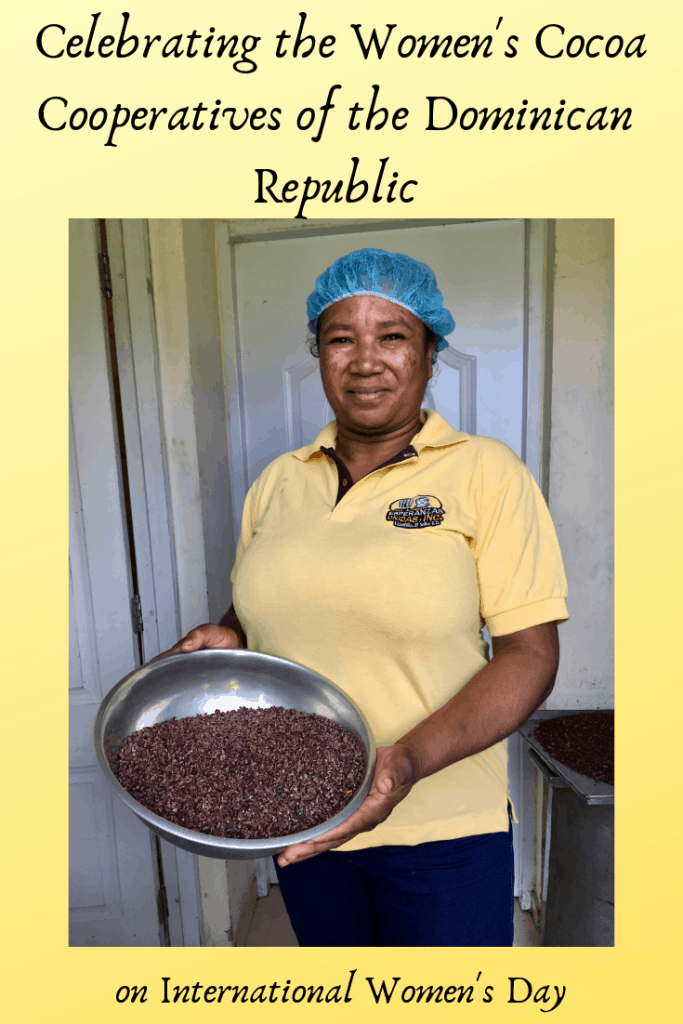
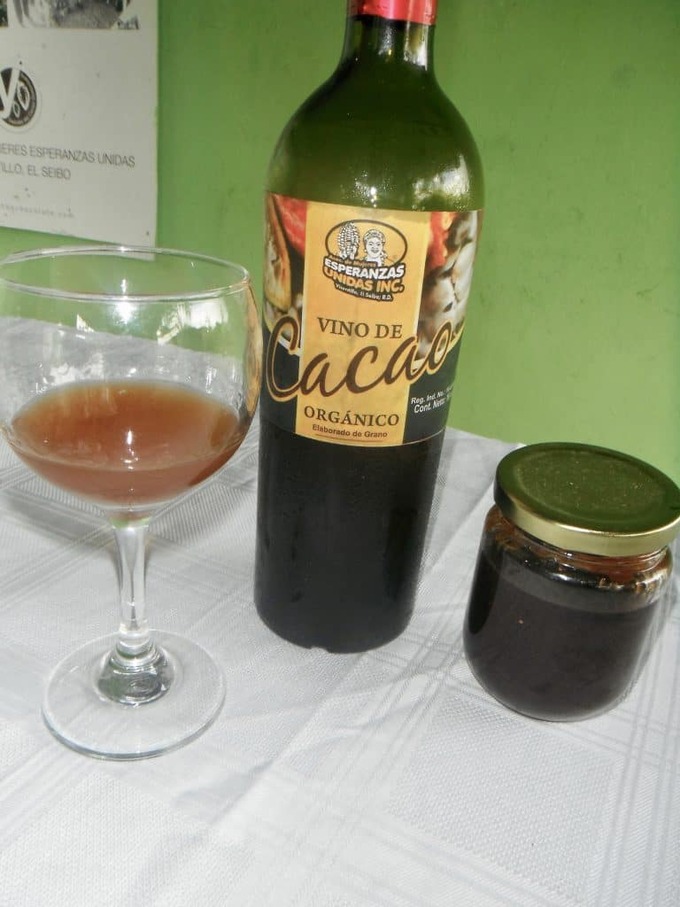
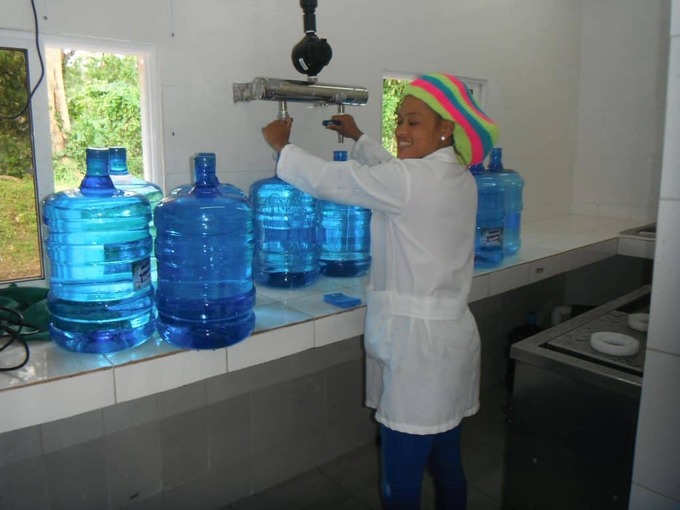
In addition to cacao-based products, the women’s cocoa cooperative in El Siebo treats and distributes bottled water. This activity is an excellent income-generating stream for the group. El Siebo is an hour’s drive from Hato Mayor and a 90-minute drive from Punta Cana. As you can see from the photo below, there had been a fair amount of rain prior to my visit and the road was washed out in places, so it not a drive for the faint of heart.
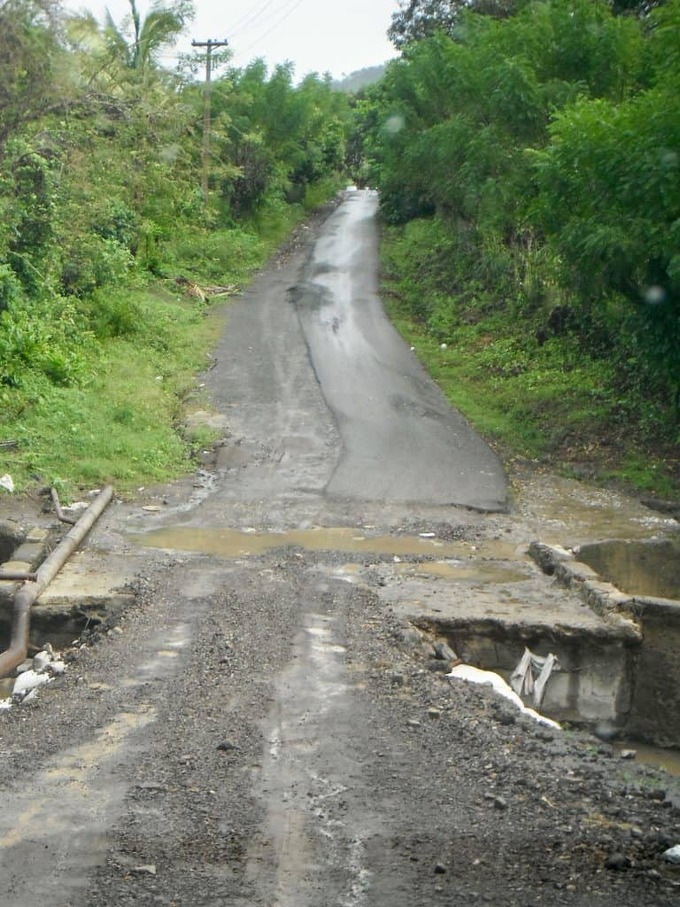
Another women’s cocoa cooperative that is struggling, but moving forward is the Chocal group of Altamira (in the Puerto Plata region of the Dominican Republic.)
Chocal has a Spanish site at https://chocalaltamira.wordpress.com/el-origen-de-chocal/but my friend Donna Janke has an excellent post on her site about her visit to the women’s cocoa cooperative as part of ‘cruise voluntourism’ activities offered by Fathom Travel.
The chocolate and cacao industry in the Dominican Republic is thriving, in part due to the efforts and guidance provided by the Comisión Nacional Del Cacao. I share their story in this post. I hope that re-sharing this collection of DR posts will encourage all chocolate lovers to lend their support to the farmers growing this top grade cacao used by award-winning chocolate makers around the world. Thanks in advance for your support.

Thank you for keeping us informed. I admire these women with their fortitude and strength. None of this would be easy. V
You’re welcome, Janet. Cacao is certainly not a crop for the weak spirited. It’s so susceptible to disease and is easily devastated by harsh weather. Fingers crossed that there isn’t another natural disaster that makes it even tougher. ❤️
If women controlled the world things would be vastly different – as proven by the success of these cooperatives. Collaboration is the key. So sorry to hear about the devastation of yet another storm in the region.
Thanks so much for your comment, Ceci, Hopefully, the DR will recover from the devastation it has been subjected to.
I am glad to read about another successful women’s cooperative. Thanks for this interesting article.
Yikes! That road looks frightening to try to navigate! It must have been very satisfying to visit with the women from the cooperative. That’s inspiring that they are thriving in their little town.
Hi Sherryl. That road was indeed frightening! I was grateful that my host, Eric Reid, is familiar with the roads in the DR and could navigate them effectively and safely. 🙂
It is quite inspiring and encouraging to see such success with women cooperatives and Kudos to you for bring that out. It is positive news like this that we need!
Thanks, Ami. I agree. I really try to focus on the positive in my work. Life is filled with far too many other kinds of stories that make us sad, scare us, or anger us. I want to try and give people information while making them smile or feel hopeful about the world. 🙂
Wonderful trip sharing and glad to hear about the most famous cocoa cooperatives of the dominican republic. Thanks.
You’re most welcome. Stay tuned for more about the DR.
Any post about chocolate and women getting together in a cooperative and making it work is awesome in my book. I love the smell of roasting beans. Thanks for linking up and sharing.
Hi Jan. Yes, there’s something about women and chocolate, isn’t there? 🙂 I’m really hopeful that this group of women will follow their dreams and make them come true.
Wow, Chocolate marmalade sound intriguing and incredible. I love it when women come together in a cooperative to make wonderful things happen.
HI Susan. Keep in mind this is a cacao marmalade, and not a chocolate one. There is quite a difference! There is very little sugar in the cacao version as compared to a traditional citrus fruit version. Interesting. But probably not what you’d expect.
Love when women come together to work, your post reminded me of a co-operative in India, which started with a modest loan of Rs 80, the cooperative now has annual sales exceeding Rs 3.1 billion as per stats in 2015 itself!
Lovely post dear 🙂
That is astounding, Sushmita. What kind of cooperative is it?
It’s a cooperative of women who manufacture Papadum i.e. is a thin, crisp, disc-shaped food; made out of seasoned dough made from peeled black gram flour, which is fried or cooked with dry heat.
That’s very interesting! Thx so much for sharing, Sushmita. It’s wonderful to hear how well their collective is doing!
Oh yes, It’s an inspiration for us all as well 🙂
There are so many things that I haven’t known before about chocolate. I admire your knowledge and be-ready-spirit that you always try to discover new things from chocolate. Great post! Please keep updating your experiences <3
Thanks very much, Linh. One thing that I have learned is that I will never know all there is to know about chocolate. It is such a large and encompassing world. And so I have devoted myself to learning all I can and am happy to share.
I find it inspiring as a woman knowing that they were able to put up a cooperative. And how they manage to start it up and help not only other women but also the community.
HI Sandy. Yes, that is the motivation of the women’s cooperatives, and I guess of all cooperatives. To help the community as a whole and put the needs of the many ahead of the needs of a few. Power to them!
Thank you, I will come here again to explore the places you shared
I love places and initiatives that both empower locals and provide a future for marginalised or minorities.
Such a great cooperative, and let’s hope their numbers can once again grow!
Thx for your comment, Chris. We were concerned when we visited, as at first, it seemed like the ladies were unclear as to their future. They were discouraged by their low numbers. But once we started taking with them about how they could change things, they seemed to reach a common focus and heightened spirits. I hope they follow through on their goals.
What a motivating and incredible group of women! Even though it is hard to build your vision, clearly it can pay off in so many ways. This article was a true example of that. Once again, thank you so much for sharing your chocolate wisdom and experiences Doreen!
Thank you for your very kind words, Erin. So glad you are enjoying my posts.
Their goals are simple but clear and certainly good ones for a business to put before them. It’s always a delight to read about the small companies who are doing so much…with much more to come. I’m sure we’ll hear about them in the future.
Thanks so much for your comment, Rose. I think that now that there group has made note of their goals, they will have a better chance in achieving them.
How inspiring Doreen! This reminds me of some of the women’s cooperatives I’ve learned about through KIVA, such a wonderful organization! Thank you for sharing and, as always, love your photographs. 🙂
Thx so much for your comment, Marty. I’ve heard of KIVA, but have never had any experience with them. Have you been involved in any projects with them? Perhaps it is on your site that I heard about them?
I knew these co-ops existed but didn’t know too much about them. It’s so great that you visited one and shared your experience!
Thx for your comment, Dannielle. I think each coop is slightly different. I visited a couple coops in Peru that we’re family groups and found them very interesting as well.
It’s really great to see how this long-standing group is still making movement in the cocoa production industry. The cocoa marmalade certainly sounds interesting!
Hi Emily. I think this group could really move forward on some good ideas with some help. The marmalade has the potential to be a great and sustainable product with just a little tweaking.
The road looks severely damaged. However, you are doing a great job with your blog giving shout outs to women only cooperatives. I would love to taste the chocolate made by Asociación de Mujures Esperanzas Unidas.
Thx for your comment, Tania. I think the folks who live in the rural areas are used to their roads being washed out. I’ve seen this in other countries besides the DR. The chocolate made by the ladies contains some coconut oil. It was not my favourite, but I appreciate their efforts and willingness to learn.
I was very glad to read about another successful women’s cooperative. The washed out roads must require very skillful drivers to navigate them. You do have adventures, Doreen!
Indeed, Bev! I was very grateful for the driving skills of my host Eric Reid, as he navigated those roads without difficulty. It’s all part of the authentic adventure! 🙂
Love hearing about a women’s cooperative. It is just great to hear about women throughout the world lifting themselves up. And with such a long history, they must be doing something right.
Hi Erica. Indeed. It’s encouraging to see these women’s groups forming and trying to re-evaluate the way they’re doing things, so that they might survive and grow.
Hi…we have open sourced our homemade 50lb roaster and winnowing….both are made from local junk and easy to construct….the roaster uses charcoal and the winnower needs electricity….please pass this on to the respective coops
Thanks for your input, Kim. Yes, I have indeed seen your homemade equipment and have tasted the incredible chocolate that results from it. The ladies are already roasting and winnowing with equipment they purchased via a low-interest government loan. But they have not yet tried fermenting or drying their own beans. Hopefully they will be able to add those key steps to their process, as they could definitely increase their rate of return if they did.
“Women united in hope” indeed ! Good to see. Very glad you added this to your chocolate experience.
Thanks, Linda. I am so fortunate that my hosts put together an incredible itinerary for me that showcased every segment of the cacao chain in the Dominican Republic. I think you’ll enjoy the next post, too. Stay tuned1
The chocolate sherry and the chocolate marmalade sound interesting. Did you enjoy the taste? Is the sherry a sipping wine or more of a cooking wine?
Hi Linda, and thx for your interest. Please know, both the “wine” and the marmalade are cacao, and not chocolate flavoured. There are no chocolate notes whatsoever in the flavour profiles, texture or colour (although the marmalade is brown.) I was not fond of the ‘wine’ and reckon it more to sherry. But not a smooth sipping sherry. Perhaps it would be good in cooking. I think the recipe needs a bit of work. The marmalade is more palatable. I think it pairs nicely with cream cheese and I eat it on bagels.
Well that’s a very honest assessment, Doreen. Which explains why you didn’t address the flavor of these products. lol. But kudos for them for experimenting and thinking outside of the box.
Doreen – thank you for sharing this. I find it inspirational to see women in developing countries pushing forward. It gives an element of hope.
It does indeed, Phoenicia. I am so inspired by these stories, and am happy to share them. Thx for stopping by to comment.
What a wonderful project, Doreen. Love the fact that it’s carried out by women.
I’m always inspired by your knowledge of chocolate Doreen, and have been lucky to take part in two of your excursions, so I felt extremely fortunate to be able to visit and help out at the Chocal Women’s Chocolate Cooperative in Puerto Plata, Dominican Republic, with Fathom Impact Travel in January. We helped with de-shelling nibs, putting stickers on the packages, planting seeds and more. It was a wonderful experience, plus we helped increase production for these hard-working women. They have shown so much promised that they’ve secured a substantial loan and are expanding their chocolate sales to Canada. I’ll be looking for their delicious treats on our store shelves!
Thx so much for sharing your experience with us, Suzanne. And thx for the compliment! I have indeed learned much about chocolate and cacao in the 8 years I have been researching it. But I still have much to learn! Thx for sticking me along the way.
Thanks Doreen for listing my post about Chocal. I hope the cooperative in El Seibo does well. Chocolate marmalade sounds pretty good. Selling bottled water for added income is a good idea. That road may not have been for the faint of heart, but the scenery looks lovely.
Thanks so much for your comment, Donna. and you’re welcome about sharing your post. It’s an excellent one, and shows quite a difference experience than what I had at El Seibo.
Women often seem to be so good at forming cooperatives. Thanks for sharing this successful one with us.
You’re welcome, Wendy. Yes, I think we women like to work collaboratively vs competitively. Thx for sharing your perspective.